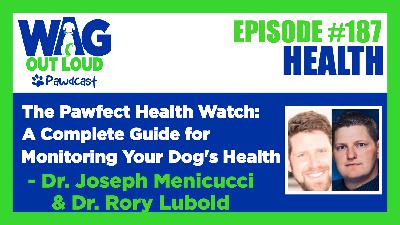Every Dog's Eyes Tell a Story ... & it's not what you think
Update: 2023-08-02
Description
Well hello! This is Krista with Episode #181 on the Wag Out Loud pawdcast. Have you checked out all of the amazing trusted brands that I highly recommend? Well, these are products that I've researched, that I've tried, and I know like and trust. These products will help your dog to thrive. So just go to WagOutLoud.com And check out the trusted brands section. And I've negotiated discounts for most of the products, so why not see what can make a difference in your dog's life? And don't forget to also check out the resources page as well, because it's filled with some very important information for both you and your dog.
Well, our new puppy Dutton is starting to lose his puppy teeth. Did you know that a puppy is born without teeth, but will have their 28 baby teeth in place by the time they are about six weeks old? And a puppy starts teething at 12 to 16 weeks of age. And normally by six months of age, all permanent teeth have erupted and all the baby teeth have fallen out. Bye bye sharp baby teeth!
Welcome to the Wag Out Loud pawdcast, where we are obsessed with bringing you helpful tips on canine health care, nutrition, and overall wellbeing. If you'd like to support the show, check out the amazing online events, products and resources that I personally recommend on the Wag Out Loud website. I'm your host, Krista and I'm super excited to be bringing you yet another tail wagging episode.
You will never "look" at your dog the same after hearing from Board Certified Animal Naturopath, Poppy Phillips, on Animal Iridology. The eyes are not only windows to the soul, iridology, the study of the iris, offers insight to your pets' wellness. Learning about the basics of iridology can empower dog guardians to know if your canine companions are needing some extra care in certain areas of their bodies, stress levels, help assess if your dog's current nutritional protocol is working effectively, and help track diagnosed diseases.
Hello, hello dog lovers! We have a another fascinating episode of the Wag Out Loud pawdcast in store for you. And with me today is Poppy Phillips and she is going to cover a topic totally new to me. It's every dog's eyes tell a story and it's not what you think. So Poppy, I am so thrilled to have you on the Show today. Thanks for being here.
Thank you for having me. I'm super excited being here today, too.
Yay. Well, this is gonna be a learning experience, I think for most of us. So why don't we start by having you introduce yourself and tell us how you got into iridology.
I am a Board Certified Animal Naturopath from and went to a College that offered an animal naturopathic program and also taking courses from Clinton college and some other naturopathic type colleges. I studied animal and human nutrition at Cal Poly. And also at Delta College. I was a year and a half away from a dietitian license and I didn't believe in the food pyramid. So I bounced out and just dove into the natural, holistic aspect. I was not going to tell people to eat jello. wasn't going to do it. And so I've taken I'm certified in homeopathy. I am an AI tech for horse reproduction. I've been a horse trainer and started Equine Alternatives first back in 1998. And then just rolled into other animals with muscle testing, and then adding other modalities like herbs and diet and so it became kind of like a life health coaching for your animals. But iridology was a course offered at College. And I thought it was a total joke. I thought it was like this woo woo ridiculous thing, but it was affordable. And I thought it would set me apart because I didn't know any animal iridologists. So I jumped on board and halfway through the, it was a two day like six hour thing. And halfway through it, I was just blown away by it and just wondered why nobody was doing this. So I was all in after that and started to document I actually tried to prove it wrong. And there are some glitches to to what we figured out. I have a membership and we try to passionately do research and advanced animal iridology so I have like four veterinarians that submit eyes and their whole case studies and we learn from that.
Wow. Okay, so it's been a journey for you.
Yes, it is. And every year we we learn more and more.
Well, because I never knew this even existed before I talked to you. Can you share with the listeners what is iridology.
WHAT IS IRIDOLOGY?
Iridology is the study of the colored part of the eye. And so if you I'm sure all of you have looked deeply into your animal's eye and then went, why is that blob there? Or why is there some different coloration? And some people even go? Yeah, my animal's eyes went from like yellow to brown, or really dark. So then often they run their animals to the vet. And the vet usually says, oh, it's not a big deal. We don't know why it does that. Well, iridology does. So these superficial marks, not like abscessed corneas, or anything like that. So you have to differentiate between a legit eye issue or this superficial mark, but they can be in black or brown, gray, white or yellow. And you can detect like toxicities, Parasite load, bone alignment issues, trauma. So it's it's so exciting. And this is why I always say you'll never look at your dog or humans again, after hearing about this because you'll just be staring at every single animal’s eyes from here on out.
Well, let's dive into this. How long has this modality been around? How did it start?
WHAT IS THE HISTORY?
So they recorded Howard Carter, I think it's Howard Carter, when he discovered King Tut’s tomb, discovered silver plates of Iris markings. And so the priests were actually iridologists in ancient Egypt, and would record it on silver plates. And so they found those. I believe China probably had some recognizing aspects to it. But those were tangible plates that they had in their own hands and realized that it was iridology. And I love the fact that the priests were also your medical doctors back in the Egyptian days.
That is fascinating. Okay, so it's been around a long time.
A long time. Exactly. And fun fact, now, because of the human retina recognition system, science is looking at the retina more and more, because you know, you do those retina looking into your computer and recognizes you. But now they're detecting neurologic diseases before it manifests in the body through Iris markings. And we're starting to we're seeing the same in our own studies and research in our in the membership. So we're seeing equine neurologic issues show up before the owners are recognizing it. It is great in prevention, you can be ahead of the curve.
Oh my gosh, okay, you're blowing my mind. When I looked this up. It says animal Iridology enables the constitution of the animal to be obsessed or not obsessed, assessed. What does that mean? What does constitution mean in this case?
A constitution for me it's kind of the over all, like description of the animal's well being. So I love the fact that you can use it as a constitutional assessment. Because I also am a acute prescribing homeopath. I'm not a chronic prescribing homeopath. I haven't done those years and years of school. I wish I did, I kind of kick myself because I love homeopathy also. But you can actually since animals can't talk to you and the owners often don't know what is really going on, you can look in the iris and see the stress levels and the toxicities and just some chronic deeper marks that might have been there. And the owner didn't even know like maybe falling off that sofa did some issues or just over the top behavior. So yes, your animal guardian can communicate what they know but if it's like a rescue or something where you have no history, the eye can help you. the iris can help you determine what that personality what that intensity what that trait is. And and that definition of the whole being through the iris.
WHAT CAN BE DETECTED?
Okay. But you mentioned a few things that can be detected from iridology. Can you tell us a little bit more like what exactly by looking at the iris and the markings? What else can we see besides I think you mentioned toxicities. And you I just I just read you know bone alignment and parasite load, individual organs, their skeletal load.
Yeah glandular health, stress levels, skin, circulatory, neurologic health, levels of pain. So all your detoxifying organs, if they are not functioning, if they're getting congested, then you know, illness is setting in because your skin, your liver, your kidneys, your lymphatics, they all have to be functioning for the body to keep in alignment, to have that whole health aspect. And so you can actually see where your ailamentary aspects are functioning or not functioning the GI tract. The thing I love about iridology is they were so on top of gut health before anybody was talking about the gut microbiome. They were already talking about disease settling in the gut, and you can see where the gut is either stressed or toxic or just not fluid and functioning from the iris.
Oh, my gosh, that is amazing.
Yeah. It's just so crazy. The more I learn, the less I know. And it's just overwhelming and awesome. And it's super user friendly for the pet parent.
Well, what exactly are you and we looking at and looking for? Is it just us looking in their eye? Or do you need special equipment or tools to see better?
WHAT TO LOOK FOR?
The funny thing about cell phones is it's totally exponentialized the user friendly aspect of iridology. So back in like the 1950s, you know, you had to find somebody with a certain type of camera. And even before color photos came out, they were hand hand drawing the irises. So prior to color photos, it was all like sketches. And after color photos, you had to find somebody with a pretty elaborate photography system. But now, with the cell phone technology, anybody can take pictures of their animals eyes and gauge their wellness. So you can actually see if their diet is working,
Well, our new puppy Dutton is starting to lose his puppy teeth. Did you know that a puppy is born without teeth, but will have their 28 baby teeth in place by the time they are about six weeks old? And a puppy starts teething at 12 to 16 weeks of age. And normally by six months of age, all permanent teeth have erupted and all the baby teeth have fallen out. Bye bye sharp baby teeth!
Welcome to the Wag Out Loud pawdcast, where we are obsessed with bringing you helpful tips on canine health care, nutrition, and overall wellbeing. If you'd like to support the show, check out the amazing online events, products and resources that I personally recommend on the Wag Out Loud website. I'm your host, Krista and I'm super excited to be bringing you yet another tail wagging episode.
You will never "look" at your dog the same after hearing from Board Certified Animal Naturopath, Poppy Phillips, on Animal Iridology. The eyes are not only windows to the soul, iridology, the study of the iris, offers insight to your pets' wellness. Learning about the basics of iridology can empower dog guardians to know if your canine companions are needing some extra care in certain areas of their bodies, stress levels, help assess if your dog's current nutritional protocol is working effectively, and help track diagnosed diseases.
Hello, hello dog lovers! We have a another fascinating episode of the Wag Out Loud pawdcast in store for you. And with me today is Poppy Phillips and she is going to cover a topic totally new to me. It's every dog's eyes tell a story and it's not what you think. So Poppy, I am so thrilled to have you on the Show today. Thanks for being here.
Thank you for having me. I'm super excited being here today, too.
Yay. Well, this is gonna be a learning experience, I think for most of us. So why don't we start by having you introduce yourself and tell us how you got into iridology.
I am a Board Certified Animal Naturopath from and went to a College that offered an animal naturopathic program and also taking courses from Clinton college and some other naturopathic type colleges. I studied animal and human nutrition at Cal Poly. And also at Delta College. I was a year and a half away from a dietitian license and I didn't believe in the food pyramid. So I bounced out and just dove into the natural, holistic aspect. I was not going to tell people to eat jello. wasn't going to do it. And so I've taken I'm certified in homeopathy. I am an AI tech for horse reproduction. I've been a horse trainer and started Equine Alternatives first back in 1998. And then just rolled into other animals with muscle testing, and then adding other modalities like herbs and diet and so it became kind of like a life health coaching for your animals. But iridology was a course offered at College. And I thought it was a total joke. I thought it was like this woo woo ridiculous thing, but it was affordable. And I thought it would set me apart because I didn't know any animal iridologists. So I jumped on board and halfway through the, it was a two day like six hour thing. And halfway through it, I was just blown away by it and just wondered why nobody was doing this. So I was all in after that and started to document I actually tried to prove it wrong. And there are some glitches to to what we figured out. I have a membership and we try to passionately do research and advanced animal iridology so I have like four veterinarians that submit eyes and their whole case studies and we learn from that.
Wow. Okay, so it's been a journey for you.
Yes, it is. And every year we we learn more and more.
Well, because I never knew this even existed before I talked to you. Can you share with the listeners what is iridology.
WHAT IS IRIDOLOGY?
Iridology is the study of the colored part of the eye. And so if you I'm sure all of you have looked deeply into your animal's eye and then went, why is that blob there? Or why is there some different coloration? And some people even go? Yeah, my animal's eyes went from like yellow to brown, or really dark. So then often they run their animals to the vet. And the vet usually says, oh, it's not a big deal. We don't know why it does that. Well, iridology does. So these superficial marks, not like abscessed corneas, or anything like that. So you have to differentiate between a legit eye issue or this superficial mark, but they can be in black or brown, gray, white or yellow. And you can detect like toxicities, Parasite load, bone alignment issues, trauma. So it's it's so exciting. And this is why I always say you'll never look at your dog or humans again, after hearing about this because you'll just be staring at every single animal’s eyes from here on out.
Well, let's dive into this. How long has this modality been around? How did it start?
WHAT IS THE HISTORY?
So they recorded Howard Carter, I think it's Howard Carter, when he discovered King Tut’s tomb, discovered silver plates of Iris markings. And so the priests were actually iridologists in ancient Egypt, and would record it on silver plates. And so they found those. I believe China probably had some recognizing aspects to it. But those were tangible plates that they had in their own hands and realized that it was iridology. And I love the fact that the priests were also your medical doctors back in the Egyptian days.
That is fascinating. Okay, so it's been around a long time.
A long time. Exactly. And fun fact, now, because of the human retina recognition system, science is looking at the retina more and more, because you know, you do those retina looking into your computer and recognizes you. But now they're detecting neurologic diseases before it manifests in the body through Iris markings. And we're starting to we're seeing the same in our own studies and research in our in the membership. So we're seeing equine neurologic issues show up before the owners are recognizing it. It is great in prevention, you can be ahead of the curve.
Oh my gosh, okay, you're blowing my mind. When I looked this up. It says animal Iridology enables the constitution of the animal to be obsessed or not obsessed, assessed. What does that mean? What does constitution mean in this case?
A constitution for me it's kind of the over all, like description of the animal's well being. So I love the fact that you can use it as a constitutional assessment. Because I also am a acute prescribing homeopath. I'm not a chronic prescribing homeopath. I haven't done those years and years of school. I wish I did, I kind of kick myself because I love homeopathy also. But you can actually since animals can't talk to you and the owners often don't know what is really going on, you can look in the iris and see the stress levels and the toxicities and just some chronic deeper marks that might have been there. And the owner didn't even know like maybe falling off that sofa did some issues or just over the top behavior. So yes, your animal guardian can communicate what they know but if it's like a rescue or something where you have no history, the eye can help you. the iris can help you determine what that personality what that intensity what that trait is. And and that definition of the whole being through the iris.
WHAT CAN BE DETECTED?
Okay. But you mentioned a few things that can be detected from iridology. Can you tell us a little bit more like what exactly by looking at the iris and the markings? What else can we see besides I think you mentioned toxicities. And you I just I just read you know bone alignment and parasite load, individual organs, their skeletal load.
Yeah glandular health, stress levels, skin, circulatory, neurologic health, levels of pain. So all your detoxifying organs, if they are not functioning, if they're getting congested, then you know, illness is setting in because your skin, your liver, your kidneys, your lymphatics, they all have to be functioning for the body to keep in alignment, to have that whole health aspect. And so you can actually see where your ailamentary aspects are functioning or not functioning the GI tract. The thing I love about iridology is they were so on top of gut health before anybody was talking about the gut microbiome. They were already talking about disease settling in the gut, and you can see where the gut is either stressed or toxic or just not fluid and functioning from the iris.
Oh, my gosh, that is amazing.
Yeah. It's just so crazy. The more I learn, the less I know. And it's just overwhelming and awesome. And it's super user friendly for the pet parent.
Well, what exactly are you and we looking at and looking for? Is it just us looking in their eye? Or do you need special equipment or tools to see better?
WHAT TO LOOK FOR?
The funny thing about cell phones is it's totally exponentialized the user friendly aspect of iridology. So back in like the 1950s, you know, you had to find somebody with a certain type of camera. And even before color photos came out, they were hand hand drawing the irises. So prior to color photos, it was all like sketches. And after color photos, you had to find somebody with a pretty elaborate photography system. But now, with the cell phone technology, anybody can take pictures of their animals eyes and gauge their wellness. So you can actually see if their diet is working,
Comments
In Channel
























